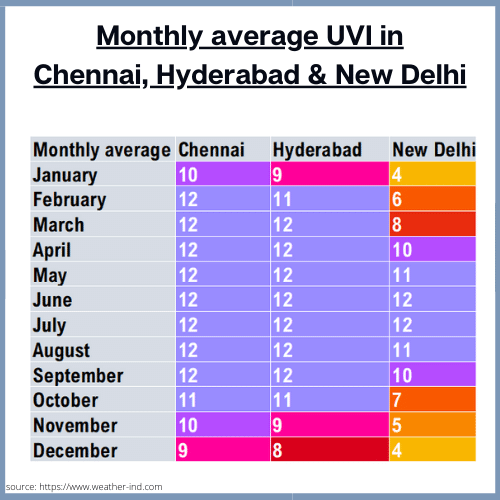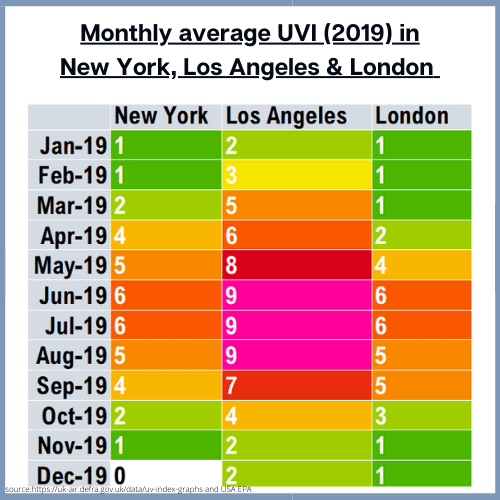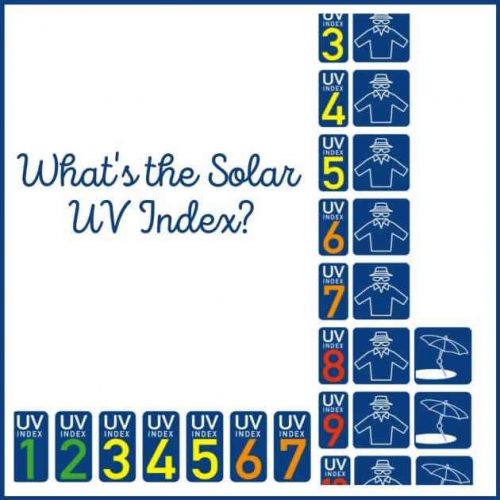The first time I came across the Solar UV Index or simply UVI number, was when I read this WHO (World Health Organisation) guidance. Here is the LINK to that document
The WHO writes, “the Global Solar UV Index (UVI) described in this document is a simple measure of the UV radiation level at the Earth’s surface and an indicator of the potential for skin damage.”
It is a public awareness tool and alerts the general public as to when to use protective measures (including when to use sunscreen, seek shade and wear protective clothing) when exposed to UV radiation.
In technical terms, UVI is…
UVI is a measurement of the intensity of UV radiation at a given time. The UVI number measures erythemal UVR and therefore, focuses on avoiding sunburn.

So if the UVI number is 1 or 2, then this tells you that you don’t need sunscreen.
Just to remind you, that these are the deleterious effects of over-exposure to UV radiation.

The UVI number is really useful but its shortcomings are that it focuses on erythema, which is mainly caused by shorter wavelength, higher energy UVB. It can take several hours of UVA exposure (depending on time of day, seasonality) for UVA to cause the same level of erythema as caused by UVB in one hour.
I think this is not a deliberate mishap on part of the WHO because UVA radiation has also been implicated in causing skin cancer. It is just a historical consequence of when this was written: ages ago when we possibly didn’t know as much about the dangers of UVA. And, in the next section I will show you how that can matter.
Country specific UV Index
Most countries, make publicly available a Solar UV Index as part of a weather forecasts and online. I have looked at the UVI for cities in which most of my readers reside in.

Irrespective of the time of year, if you live in Chennai, Hyderabad or New Delhi, you should be using sunscreen every day per the UV Index.
However, for residents of New York, Los Angeles and London, the UV Index indicates that you don’t need to wear sunscreen everyday.

BUT, Krutmann et al write “photoaging of human skin mainly results from daily exposure to non-extreme, low doses, which does not cause any visible changes at times of exposure while leading to biological changes and that UVA rays and in particular, long wavelength UVA1 is a major contributor.”
I have used this specific quote because I like it, but the fact remains that the scientific evidence on this particular issue is no longer up for challenge and it is staggering that the UV Index has not been adopted to reflect this.
Better still would be a replacement of the UV Index with something that reflects the harm caused by UVB and UVA on a daily basis. (Not saying this would be easy, but it would be a step in the right direction).
How do you know when to wear sunscreen when the UV Index says not too…
My short answer is to be on the safe side, where sunscreen daily – at least an SPF 30 with strong UVA protection. UVA does penetrate both cloud cover and glass – so if you are working next to a window (as I do), you are not saved from UVA. Also, I like to think of UVA as sugar – it works slowly, consistently and effectively – it will damage your skin because its effects are cumulative and can’t be reversed
When in doubt…
Keep calm and slap on sunscreen….
Sources: WHO, Jean Krutmann, Anne Bouloc, Gabrielle Sore, Bruno A. Bernard, Thierry Passeron, The skin aging exposome, Journal of Dermatological Science, Volume 85, Issue 3, 2017, Pages 152-161
See also
